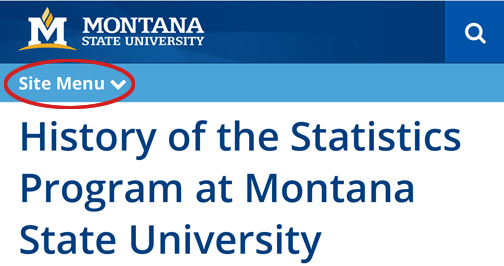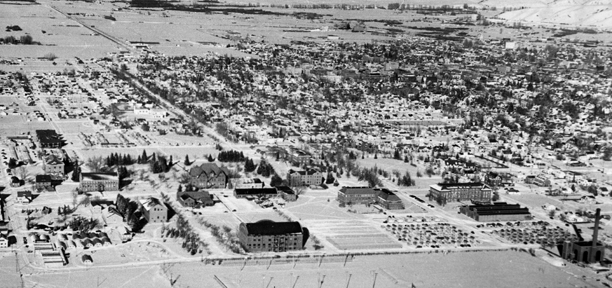History of the Statistics Program at Montana State University
by Martin (Marty) A. Hamilton and
Richard (Dick) E. Lund
MSU Professors Emeritus of Statistics
About the Authors
How to navigate this ebook:
Navigation is provided in two different ways depending on the reading device:
- On a desktop computer, navigation is provided in an Eras panel located to the left of the text. The Eras panel displays a separate drop-down menu for each of the ten eras. Selecting an era produces a menu of navigation links to each topic within the era.
- On a small device such as a smart phone, there is no space for a panel beside the text of the book. Navigation is accessed from the "Site Menu" located under the MSU logo near the top of the screen (circled in display below). Selecting the Site Menu opens the Eras panel allowing the reader to navigate to topics within eras. The text of the book is located below that panel.

To navigate directly to a desired era/topic, a reader also can use the Table of Contents, which is a web page version of the navigation pane.
One can read the book sequentially in the order of the Table of Contents by selecting Next at the end of a web page.
The "back button" or "back gesture" on your device or browser can speed navigation.
We identified a few places in the text where the reader may wish to view related material elsewhere in the book, then return to continue reading. We often put navigation links in the text for making the back and forth jumps; however, the "back button" or "back gesture" on your digital device or browser may well be preferable. Most of the "related material" topics are not displayed in the main navigation panels.
How to View Notes and Citations
A superscript number indicates a note or citation. Selecting that number takes you to the note or citation in the table of Notes and Citations. To return from the table to your reading position in the text, use the "back button" on your digital device or select the return arrow ↑ displayed in the table. You can see the entire table of Notes and Citations by navigating from the Eras panel.
Some notes or citations contain a URL address for further information. To go to the corresponding web site, you could highlight and copy the URL (into the clipboard on your device), open a new tab on your browser, and paste the URL into the address bar.
Images
It may well be possible to view more detail in a selected image, depending on your reading device. On many smart phones, a menu drops down if you long-touch the image. On many desktop computers, right clicking on the image produces a menu. Use the back button on your device to navigate back to your reading location.
Table of Contents
Preface
The Statistics faculty in the Mathematics Department at Montana State University (MSU) in 1970 consisted of four statisticians – Franklin (Frank) S. McFeely, Kenneth (Ken) J. Tiahrt, Richard (Dick) E. Lund and Martin (Marty) A. Hamilton. These four were the first PhD-trained statisticians to remain at MSU until retirement.
In 2018, the 125th anniversary year of MSU's founding, we (Dick Lund and Marty Hamilton) were motivated to look at the history of the Statistics Program and learn something about our predecessors, successors, and the events that led to MSU's present excellence in statistics. Our two deceased colleagues, Frank and Ken, would have willingly shared authorship of this history project. We miss them and the insight they could have provided.
When Frank McFeely retired in 1985, he was the first PhD-trained Statistics Professor to retire from MSU. The statistics professors who served prior to 1970 left MSU before retirement. Their arrivals at MSU, departures, and subsequent careers are described in this book, as well as such information for all statistics professors who served since 1970.
William Tallman, a mathematician, was an important contributor to the statistics component of the Math Department from 1901 to 1945. Tallman was the first Professor of Mathematics, first Mathematics Department Head, and first Professor Emeritus of Mathematics at MSU. For many years, he was the only Professor in the Department. Although he never received formal training in statistics and he didn't hold a PhD degree, he taught both statistics and mathematics for decades. Also, he sometimes served as a statistical collaborator with campus researchers.
In the late 1800s, statistics typically was not included in university curricula in the U.S. It is not surprising that MSU offered no statistics courses during that time. However, at the beginning of the 1900s, William Tallman introduced the mathematics course “Method of Least Squares” that involved some statistical thinking. The first actual statistics course was taught by Tallman in 1910, but its topics were somewhat behind the latest important developments in the field. It would take a few decades for courses at MSU to catch up.
By the middle of the twentieth century, the Statistics Program at MSU was imparting contemporary statistical theory and methods, and the statisticians were contributing to advancements in the field. By 1970, the Statistics Program was attracting excellent students, its professional service in consulting/collaboration was important to the university, and its research productivity was widely recognized and often cited. Now in 2019, we find that the Statistics Program at MSU quietly has become the regional academic leader. MSU is the focal center for statistical education, research, and service within an area serving a huge region of hundreds of thousands of square miles in the northern Rocky Mountains and northern Great Plains areas.
We present the story of statistics at MSU in chronological order. We partitioned MSU's history into ten "eras," which are significant time intervals previously emphasized by MSU historians. Note that, in the early eras, the school was known as Montana State College or MSC. We use MSC to identify the institution in chapters covering those eras.
To complete our main theme, "Statistics Program at MSU," we include additional information about events that defined the circumstances and environment within which the Statistics Program was created. We hope that such correlative information provides context for understanding the fluctuations and growth of the Statistics Program. For each era, we include the following three topics:
The topic Notable Advances in Statistics, is a review of advances in statistical theory and computational technology in the
world at large. It will become clear that, the our statistics curriculum of the early
1900s was far behind the field, but it caught up by 1970.
The topic Annals of MSU presents events in the history of the university that potentially affected the Statistics
Program or its students and staff. It describes changes in the University's leadership,
goals, and resources, as well as decisions, especially by Montana's Governor, Legislature,
and higher education leaders, that influenced the academic environment.
The topic Significant National Events is a summary of U.S. national events, including wars, recessions, political trends,
and other events that potentially affected MSU students and faculty, and the Statistics
Program.
Our presentations of these topics are necessarily influenced by our personal interests, experiences, and opinions, but we believe that stated facts are correct.
The presentation for each era contains at least the topics just described. As you will see in the navigation menus, we have provided additional topics of interest for some eras. At the end of this book, we include a list of the Notes that are cited throughout the text. The navigation menu contains a direct link to the Notes.
We quote freely from three excellent books about the history of MSU, written to celebrate the 75th, 100th, and 125th anniversaries of the founding of this University, and from a recent widely-appreciated book on U.S. history. The four books and their individual citation abbreviations (based on the titles) are:
A History: Montana State University by Merrill G. Burlingame, (Bozeman: Office of Public Information, 1968), cited as History1968 ;
In the People’s Interest: A Centennial History of Montana State University by Robert Rydell, Jeffrey Safford, and Pierce Mullen, (Bozeman: Montana State University
Foundation, 1992), cited as IPI1992 ;
Democracy by Degrees: The 125th Anniversary History of Montana State University by Robert W. Rydell, (Bozeman: Montana State University, 2018), cited as DBD2018 ; and
These Truths: A History of the United States by Jill Lepore (W. W. Norton & Company, first published September 18, 2018), cited
as TT2018 .
The chapters of the above three MSU histories defined the "eras" used in this book. We hope you will read these informative and entertaining literary works that together cover 1893 to 2018 at MSU and in Montana and the Nation.
Through all the ebbs and flows that buffeted and advanced their program, the Statistics faculty and students steadfastly taught, learned, researched, and served. The foundation of the program was built and strengthened by those people and we attempt to introduce them to you. We may have inadvertently omitted someone. We will gladly update this history when any such omissions or other errors are brought to our attention. We dedicated our professional lives to statistical teaching, research, and service at MSU and have enjoyed the opportunity to chronicle the history of our program. We hope our findings are informative and thought-provoking.
Acknowledgments
We have been fortunate to have the support and cooperation of the folks who now are the Department of Mathematical Sciences. We have benefited greatly from information provided by Department Head Elizabeth Burroughs, her staff, and the presently active faculty and students. Thanks especially to former colleagues and students, some of whom we were able to interview.
Next
Table of Contents
Last revised: 2021-06-06

